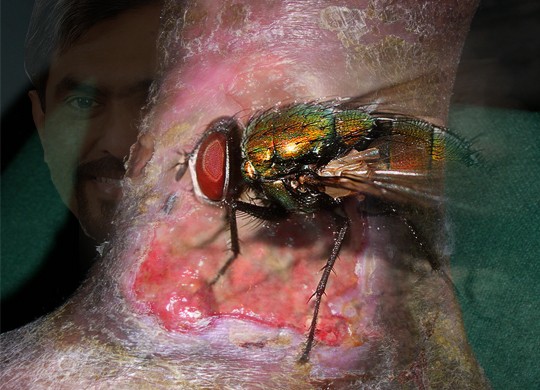Good?

I’ve seen creepy worms in wounds. In a bad—really bad!—case of leprosy, many years ago, on a farmer who did nothing about his disease. Open wounds with gruesome maggots! Straight out of some horror movie. Very high Yuck! factor, indeed!
But, apparently, they can do you good.
In a recent issue of one of the major journals of my discipline, The Archives of Dermatology, researchers in Caen and Lyon, France, studied 119 patients with a non-healing, sloughy wound 40 cm² or smaller, less than 2 cm deep. Non-healing wounds are a troublesome problem, that leads to further morbidity. So physicians do all they can to help the healing of these lesions along. During a 2-week hospital stay, half the research patients received either maggot debridement therapy (fancifully, and perhaps, less nauseatingly, known as “MDT”). Debridement is the scraping off of dead tissue, usually with a scalpel. The maggots were applied in dressings, the parasites enclosed in a mesh that was laid on the wounds. The other half had a standard bandage and scalpel debridement.
(Patients wore blindfolds during this experiment—understandable, because knowing what they might be receiving on their wounds, both groups reported feeling crawling sensations!)
The maggots (i.e., baby flies in the larval—worm—stage!) took only half the time to clean out such wounds effectively compared to the sharp stainless steel implement. The heroes here were the species Lucilia sericata, the green bottle fly, members of which feed on necrotic tissue, breaking it down.
This approach is not very new; it’s been round since antiquity. And the FDA has approved such uses of maggots since 2004. (In the 2000 film, Gladiator, Russell Crowe’s character, General Maximus Decimus Meridius, has a shoulder wound treated with maggots; and also a burn injury in an episode of House, M.D. several years ago.)
While it has been historically employed, this was one of the few studies to determine how well MDT compared with other conventional efforts. It did better. Besides, there was no discomfort and so no need for any anesthesia, unlike when you apply a blade to the skin. And less time: 10 minutes twice a week, as opposed to 40 minutes thrice a week with a scalpel. One can be handled by a nurse; the other typically needs a physician. And it’s cheaper.
Yup, you can even buy these gross beasts: “Medical Maggots.”
Nope, I don’t intend to start using them any time soon.
But you have to admit that not all things gross, abhorrent, and disgusting are bad! Sometimes, out of evil stuff comes good.
And we know that God causes
all things to work together for good
to those who love God.
Romans 8:28
When the patriarch Joseph, who had been sold into slavery in Egypt by his brothers, reconciled with that treacherous bunch, he had risen up the ranks from slave to Prime Minister of Egypt, second only to the Pharaoh. The presence of a family member in high places made it possible for his father and his siblings to survive a devastating famine. So, in his words of grace, Joseph declared:
“As for you, you meant evil against me,
but God meant it for good
in order to bring about this present result,
to preserve many people alive.”
Genesis 50:20
But the best example of evil being turned to good by God is the death of his Son, Jesus Christ.
He [God] made Him [Jesus Christ]
who knew no sin to be sin on our behalf,
so that we might become
the righteousness of God in Him.
2 Corinthians 5:21
And so for those who believe in Jesus Christ as their only God and Savior from sin, evil has been made to work good.











 Abe Kuruvilla is the Carl E. Bates Professor of Christian Preaching at The Southern Baptist Theological Seminary (Louisville, KY), and a dermatologist in private practice. His passion is to explore, explain, and exemplify preaching.
Abe Kuruvilla is the Carl E. Bates Professor of Christian Preaching at The Southern Baptist Theological Seminary (Louisville, KY), and a dermatologist in private practice. His passion is to explore, explain, and exemplify preaching.
2 Comments
Thanks, Abe, for being such a good and faithful friend to Marcy & Dave. I know that they appreciate your friendship and so do we!!
Good hearing from you, Bob & Doris.